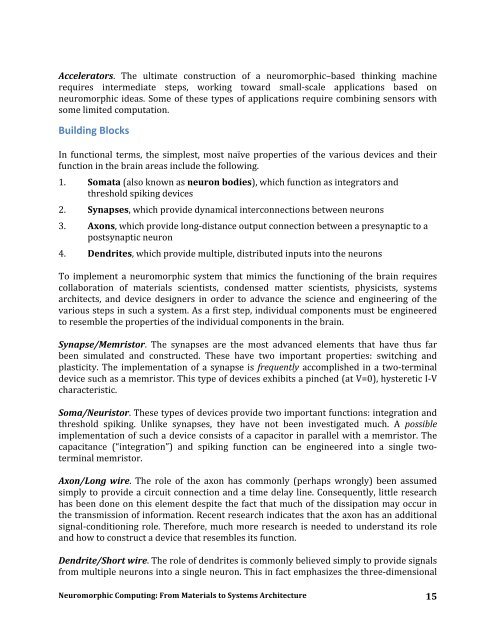Neuromorphic Computing From Materials to Systems Architecture
Neuromorphic-Computing-Report_FNLBLP
Neuromorphic-Computing-Report_FNLBLP
You also want an ePaper? Increase the reach of your titles
YUMPU automatically turns print PDFs into web optimized ePapers that Google loves.
Accelera<strong>to</strong>rs. The ultimate construction of a neuromorphic–based thinking machine <br />
requires intermediate steps, working <strong>to</strong>ward small-‐‐scale applications based on <br />
neuromorphic ideas. Some of these types of applications require combining sensors with <br />
some limited computation. <br />
Building Blocks <br />
In functional terms, the simplest, most naïve properties of the various devices and their <br />
function in the brain areas include the following. <br />
1. Somata (also known as neuron bodies), which function as integra<strong>to</strong>rs and <br />
threshold spiking devices <br />
2. Synapses, which provide dynamical interconnections between neurons <br />
3. Axons, which provide long-‐‐distance output connection between a presynaptic <strong>to</strong> a <br />
postsynaptic neuron <br />
4. Dendrites, which provide multiple, distributed inputs in<strong>to</strong> the neurons <br />
To implement a neuromorphic system that mimics the functioning of the brain requires <br />
collaboration of materials scientists, condensed matter scientists, physicists, systems <br />
architects, and device designers in order <strong>to</strong> advance the science and engineering of the <br />
various steps in such a system. As a first step, individual components must be engineered <br />
<strong>to</strong> resemble the properties of the individual components in the brain. <br />
Synapse/Memris<strong>to</strong>r. The synapses are the most advanced elements that have thus far <br />
been simulated and constructed. These have two important properties: switching and <br />
plasticity. The implementation of a synapse is frequently accomplished in a two-‐‐terminal <br />
device such as a memris<strong>to</strong>r. This type of devices exhibits a pinched (at V=0), hysteretic I-‐‐V <br />
characteristic. <br />
Soma/Neuris<strong>to</strong>r. These types of devices provide two important functions: integration and <br />
threshold spiking. Unlike synapses, they have not been investigated much. A possible <br />
implementation of such a device consists of a capaci<strong>to</strong>r in parallel with a memris<strong>to</strong>r. The <br />
capacitance (“integration”) and spiking function can be engineered in<strong>to</strong> a single two-‐terminal<br />
memris<strong>to</strong>r. <br />
Axon/Long wire. The role of the axon has commonly (perhaps wrongly) been assumed <br />
simply <strong>to</strong> provide a circuit connection and a time delay line. Consequently, little research <br />
has been done on this element despite the fact that much of the dissipation may occur in <br />
the transmission of information. Recent research indicates that the axon has an additional <br />
signal-‐‐conditioning role. Therefore, much more research is needed <strong>to</strong> understand its role <br />
and how <strong>to</strong> construct a device that resembles its function. <br />
Dendrite/Short wire. The role of dendrites is commonly believed simply <strong>to</strong> provide signals <br />
from multiple neurons in<strong>to</strong> a single neuron. This in fact emphasizes the three-‐‐dimensional <br />
<strong>Neuromorphic</strong> <strong>Computing</strong>: <strong>From</strong> <strong>Materials</strong> <strong>to</strong> <strong>Systems</strong> <strong>Architecture</strong> <br />
15


